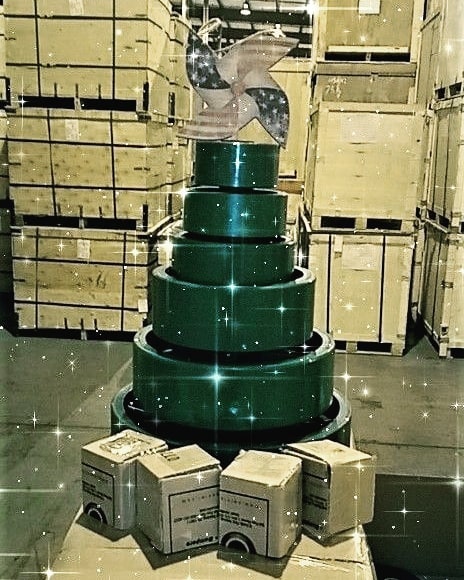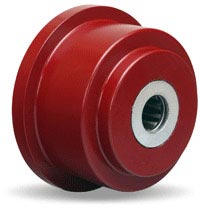We wish you the happiest of holidays! The blog will be back after the first of the year.


We wish you the happiest of holidays! The blog will be back after the first of the year.

While looking at casters and caster wheels, you may have come across the terms “Durometer” or “Shore Durometer” and an associated number and letter. What do they mean? Where did they come from? Why are they there? Read on to find the answer to these life-changing questions.
Let’s get the confusing part out of the way first. Durometer is both a measurement and a tool for measuring. In other words, you measure the durometer of an item with a durometer.
But what exactly is a durometer measuring? The hardness of an item. There are many durometer scales represented by a letter(in the caster and wheel industry we use Shore A and Shore D) ranging in numerical value from 0-100. The higher the number, the harder the item is on that particular scale. For instance, a rubber band has a durometer of 25 A. Skateboard wheels (or many of the polyurethane wheels we sell) might be between 85-95 A. This doesn’t mean that they are extremely hard, just that they are one of the hardest materials the Shore A scale can measure.
What happens when an item is harder than the Shore A Scale can measure? That’s when we move on to the Shore D scale. Any of our harder wheels, such as a phenolic resin wheel, will be measured on the D scale. A phenolic resin wheel has a durometer of 90 D. Another example of an item on the D scale would be a hard hat, which has a durometer of around 75 D.
Ultimately, the durometer of a wheel can help the user figure out how the wheel will react to its environment and the floor it is on. Will it be durable enough? Will the wheel damage the floor? Will the floor damage the wheel? Will the wheel roll over debris? These questions can be answered (or at least approximated) through the use of durometer measurements.
A confusing term at times can be bearings in regards to their use in casters. Bearings are used in casters for both wheels and swivel heads, and here we will discuss both.
Wheel Bearings
Wheel bearings sit between the wheel and axle, and provide a way for the wheel to easily spin on the axle. These bearings come in a number of different types, each with its own advantages.
Delrin bearings are inexpensive, and need no maintenance. They are a simple bushing made of Delrin, a plastic material. Delrin bearings work well in wet applications since they have no moving or metal parts that could corrode.
Roller bearings are best suited to low speed, manual operation with intermittent use. The roller bearing consists of a series of rollers arranged to sit on an axle and easily roll around it. Roller bearings can be solid or split caged. Split cage roller bearings do not handle side thrust as well as their solid counterpart, which is inserted into the wheel with a press. Roller bearings require regular maintenance.
Precision Bearings are a high quality ball bearing. These are excellent for applications that require high speed, quiet, and/or continuous operation. Precision bearings do not require regular maintenance to function properly. Semi-Precision bearings offer a less expensive, low speed and light duty option for those that still want quiet, maintenance free operation.
Tapered bearings are used on the heaviest duty casters. These bearings can handle high speeds and power driven application. Tapered bearings also handle side thrust well, and excel at continuous operation. They do require regular maintenance for good performance.
Swivel Head Bearings
Swivel Head bearings are typically ball bearings inside of a raceway. The swivel head assembly and its bearings allow for the wheel to easily turn and add steerability to applications. This raceway can be sealed or exposed. A sealed raceway protects the bearing assembly from dirt and other debris that is harmful to the bearing. The raceway can also be precision made and hardened to increase the longevity and performance of the swivel head.
Please visit our caster wheel bearings page for additional information.
The flanged caster wheel is perfect for any situation requiring the use of a track. The flange (whether dual or single) keeps the wheel from jumping off the track during use.
Flanged wheels set themselves apart from other wheels by having a lip around one or both outside edges of the wheel. Most people will be familiar with flanged wheels as those on trains or old mining carts, however they are popular for many industrial and factory setting applications.

The use of a track with a flanged wheel can provide several advantages over a standard wheel rolling on the floor. The floor itself will see less wheel wear, and the caster unit and wheel will have less chance to pick up debris on the floor. Flanged wheels also provide tracked workflow to maintain controlled mobility as well as providing the ability to easily raise or lower the work.
Another distinct advantage is the ability of the flanged caster to bring the work overhead. A good example of this is on cranes and hoists that use flanged wheels to roll on an I-beam.
Check out our flanged wheel page for more information!